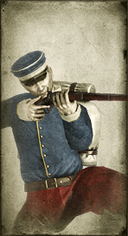
Basic Unit Statistics (can be modified by difficulty level, arts, skills, traits and retainers)
| Recruitment Cost | 1300 | |
| Upkeep Cost | 130 | |
| Melee Attack | 6 | 17% |
| Charge Bonus | 15 | 30% |
| Bonus vs Cavalry | 0 | 0% |
| Range | 150 | 23% |
| Accuracy | 45 | 45% |
| Reloading Skill | 65 | 65% |
| Ammunition | 40 | 50% |
| Melee Defence | 4 | 11% |
| Armour | 2 | 13% |
| Morale | 8 | 16% |
Strengths & Weaknesses
- Very good accuracy and reload rate.
- Long range.
- Weak in melee.
- Weak against cavalry.
- Good morale.
Description
These light infantrymen can move across the battlefield rapidly, and deliver devastating rifle fire.
Tosa riflemen are trained to act as light infantrymen, skirmishers who protect and screen the main line of battle. As such, they are excellent shots with their modern, rapid-fire, repeating rifles, and will do a substantial amount of damage to enemy units if they are not driven off. As might be expected of well-trained troops, they are also confident and have good morale. However, they should not be expected to fight well in close combat, or to last if they are ridden down by enemy cavalry. Used correctly, though, against high value and dangerous enemies, they are a formidable weapon in any general's arsenal. Tosa was the birthplace of Sakamoto Ryoma (1836-67), a visionary leader of the anti-Tokugawa faction in Japanese society. Although he was a samurai and a traditionalist in some things, such as samurai dress, he was also very open to new ideas: he certainly owned and used a Smith and Wesson rimfire revolver, for example. He had read, and favoured, the American constitution, and felt that a modern Japan would have to throw off its feudal origins and adopt policies of equality among men. His modernism would also lead him to be the leading light in the establishment of a navy to fight the Tokugawa Shogunate: he is regarded as the "father of the Imperial Japanese Navy" for his efforts to give Satsuma and Choshu a navy. He also brokered a peace between these traditional enemies. Such an able man was bound to make enemies, and he was assassinated in Kyoto; the Shinsengumi were blamed at the time.